May 14, 2017 | commemorative, currency, history, notaphily
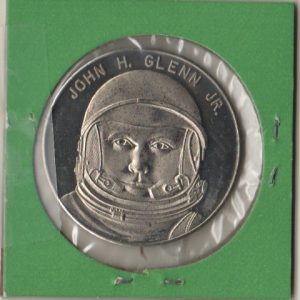 John Herschel Glenn, Jr. is a true American Hero.
John Herschel Glenn, Jr. is a true American Hero.
I feel so comfortable saying this that I will not qualify that statement with, “few will argue that ….” When you are the first American to strap yourself into a tiny capsule that is forced into space on top of the Atlas LV-3B rocket, essentially a huge Roman candle, there is no argument on his status in history.
Glenn was not only the first American in space but is also the oldest person ever to go to space. In 1998, at the age of 77, Glenn rode on Discovery on STS-95 as part of a study by the National Institute of Aging. Although the study was not criticized, the selection of Glenn was. While there will be an asterisk in history about the criticism, it will not diminish Glenn’s place in history.
While out looking for collectible inventory, I came across an auction of memorabilia from the widow of a crewman that was aboard the ship that picked up Glenn after he splashed down in the Atlantic Ocean.
On February 20, 1962, Glenn blasted off from Cape Canaveral on Friendship 7 for what ended up being a 4-hour 55-minute flight into history. During the flight, a sensor noted that a heat shield had loosened and could endanger his re-entry. Glenn was ordered to leave a solid-fueled retrorocket pack in place to protect the shield.
-

-
Parade in Florida on February 24, 1962 following the return of John Glenn.
-

-
John Glenn and General McElroy
Although Glenn’s re-entry was calculated, he carried a note that read, “I am a stranger. I come in peace. Take me to your leader and there will be a massive reward for you in eternity” in several languages, in case he splashed down in an area where the Navy was not positioned.
According to the auction house, two ships were in position based on the projections as to where Friendship 7 was supposed to splash down in the Atlantic. A third was positioned further south and then moved when calculations suggested that the retrorocket pack would change the trajectory of the capsule. When Friendship 7 splashed down further south than expected there was a race amongst the three ships to see who could pick up Glenn and etch their names into history.
The third and most southern positioned ship, the U.S.S. Randolph (CV-15), was in the best position to recover Glenn and the capsule. In the race to the area of the capsule, the Randolph arrived first and pulled Glenn out of the Atlantic. Glenn remained aboard the Randolph where he was medically examined before the aircraft carrier docked in Florida on Friday, February 23, 1962.
Saturday was shore leave for the crew of the Randolph in Key West, Florida. To celebrate, Captain Claude C. (Buddy) Inskeep and select members of his crew were invited for a pleasure cruise aboard The Big Wheel fishing boat where a number of pictures and autographs were offered.
-
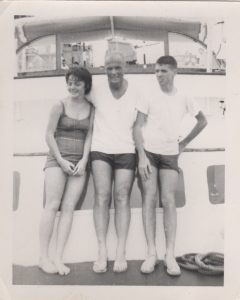
-
February 24, 1962 picture (L-R): Lyn Glenn, John Glenn, and Dave Glenn aboard The Big Wheel
-
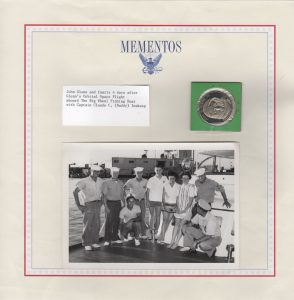
-
Memento given to the crew who visited John Glenn and family aboard The Big Wheel
In the auction lot of memorabilia were pictures of John Glenn and his family, a memento picture of some of the people on board The Big Wheel along with a medal featuring John Glenn, and an autographed $1 silver certificate.
It is the silver certificate that makes this lot a very cool find. Technically, we could call this a short snorter since it is a signed piece of paper currency of members together on a trip. But these are not ordinary autographs. From top to bottom the autographs include John Glenn’s wife Annie Glenn; John H. Glenn, Jr.; (John David) Dave Glenn (son, then 17 years old); and (Carolyn Ann) Lyn Glen (daughter, then 15 years old). Below the printed signature of Treasurer Ivy Baker Priest is written “2-24-62.”
I have no doubt that the autographs and the memorabilia are authentic. It is something that you just cannot find every day! Even though I am a dealer and should sell what I purchase, I know that this is a memento from history and of a hero who passed last year. I know I can make a hefty profit from this purchase since I know I vastly underpaid what it is worth, but I am having a hard time considering letting them go.
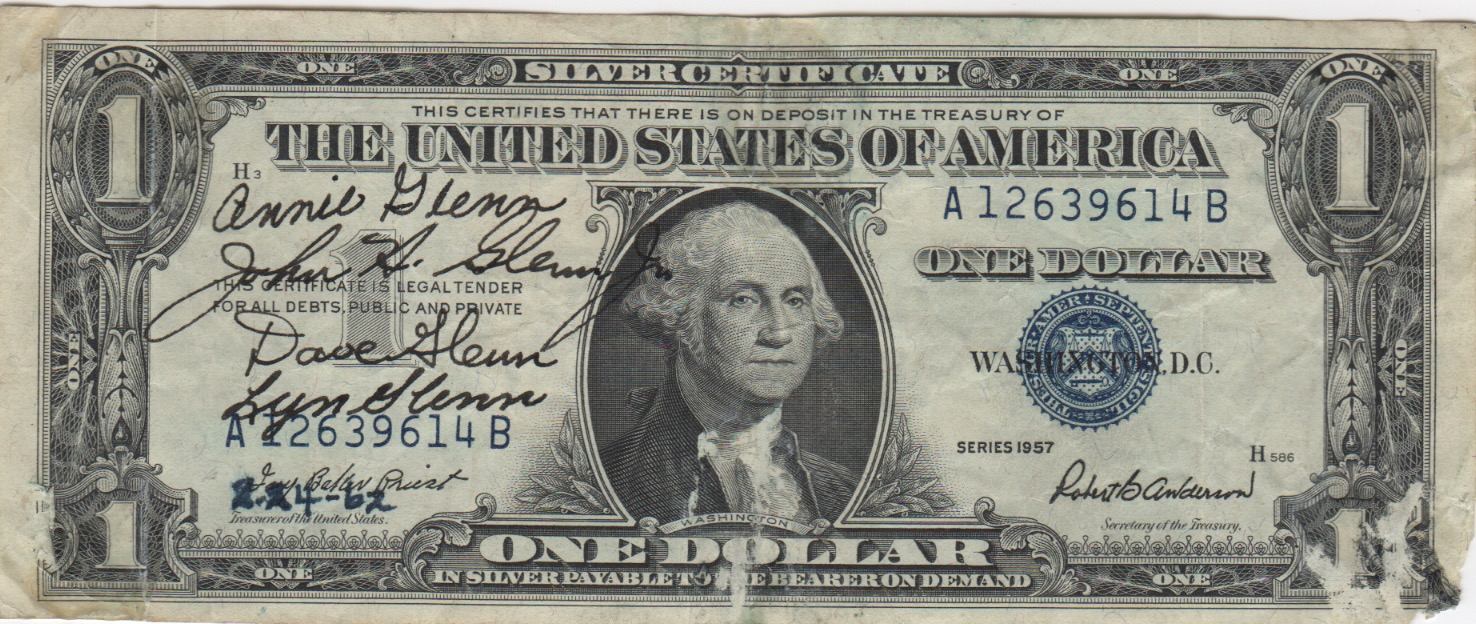
Glenn family autographed “Short Snorter” dated February 24, 1962, four days after Glenn orbited the earth in Friendship 7
For now, I own them but might entertain offers. But the offers must knock my socks off because this is just too cool to consider anything else!
-
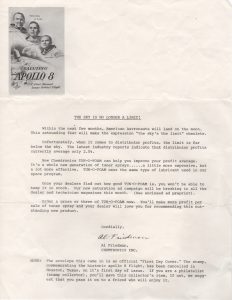
-
Letter found in the auction lot with the Glenn memorabilia
-
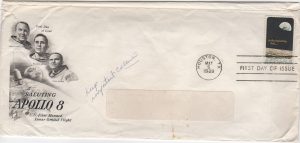
-
The First Day Cover (address redacted) that held the letter from Chemtronics, Inc.
May 16, 2011 | advice, education, exonumia, notaphily, scripophily
Numismatics is the collecting and study of items used in the exchange for goods, resolve debts, and objects used to represent something of monetary value. The dominant area of numismatics is the collection and study of legal tender coins with United States coins being the most collected. But numismatics is more than collection coins. It includes the collecting and study of:
- Exonumia—the study of tokens, medals, or other coin-like objects that are not considered legal tender. Those involved in exonumia collect elongated and encased coins, badges, counterstamped coins, wooden money, credit cards, and the like. Military medals are also collected as exonumia. And do not forget Love Tokens and Hobo Nickels, former legal tender coins with special engravings and carvings.
- Notaphily—is the study and collection of banknotes or legally authorized paper money. Notes can be collected by topic, date or time period, country, paper type, serial number, and even replacement or star notes (specific to the United States). Some consider collecting checks part of notaphily. Checks are collected by issuing bank, time period, and the signature.
- Scripophily—is the study and collection of stock and bond certificates. This is an interesting subset of numismatics because of the wide variety of items to collect. You can collect in the category of common stock, preferred stock, warrants, cumulative preferred stocks, bonds, zero-coupon bonds, and long term bonds. Scripophily can be collected by industry (telecom, automobile, aviation, etc.); autographs of the officers; or the type of vignettes that appear on the bonds.
I bring this up because a friend was asking about what to collect. He was under the impression that numismatics were coins only. I explained it was more than coins—it is anything that represents money or money-like items or even medals that represent worth. This is how military medals are considered part of numismatics. A medal representing the achievement shows the worth of the soldier as a warrior.
Showing him my collection, I showed how I have items that cover all of the areas of numismatics. New York City subway tokens and various medals are all part of exonumia. My recent interest in Maryland colonial currency and the purchase of some of the special collectibles from the Bureau of Engraving and Printing are part of notaphily. I cannot forget my small collection of stock certificates that represent the railroads in the original Monopoly game is a modest dive into scripophily.
I told my friend like I tell everyone else: why collect what everyone else collects. I collect what I like. I collect based on the “oh, neat!” factor. This is why I have a set of the Somalia Motorcycle Coins and looking for a set of the Somalia classic muscle car coins.
In other words, collect what you like and like what you collect!
Aug 23, 2008 | commemorative, foreign, notaphily
I am not a big fan of the Olympics. There are certain sports that intrigue me, but the drama of these games have drawn me in. Whether it is Michael Phelps, Dara Torrez, the beach volleyball teams, or even the running of Ussain “Lightning” Bolt, I found these games intriguing. I do understand the political aspects of the games and the comparison that I and others have to the 1936 Berlin Olympics, but that is not why I am writing today.
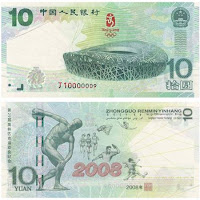 Numismatically, the 2008 Beijing Olympics has produced interesting collectibles. One collectible many have missed is a 10 Yuan note with an image of the The National Stadium, nicknamed the Bird’s Nest, rather than the traditional image of Chairman Mao Tse-tung. The reverse has the primary image of a discus thrower and smaller vignettes of other activities.
Numismatically, the 2008 Beijing Olympics has produced interesting collectibles. One collectible many have missed is a 10 Yuan note with an image of the The National Stadium, nicknamed the Bird’s Nest, rather than the traditional image of Chairman Mao Tse-tung. The reverse has the primary image of a discus thrower and smaller vignettes of other activities.
Although these notes are being printed as Renminbi, People’s Money, it is being reported that just enough of the notes are being printed for distribution within the Olympic Village. Traditional 10 Yuan Renminbi including the portrait of Chairman Mao will continue to be distributed to the rest of the country.
As of August 22, 2008, 10 Yuan Renminbi is worth US$1.46.
 The Bank of China (Hong Kong) (BOCHK) also issued a HK$20 note (US$2.56). Long lines were reported outside BOCHK offices when the notes were made available to the public. Although 4 million notes will be printed, they are not expected to see circulation. Reports say that 3.76 million notes will be sold in Hong Kong for HK$138 (US$17.68) to HK$1,338 (US$171.53).
The Bank of China (Hong Kong) (BOCHK) also issued a HK$20 note (US$2.56). Long lines were reported outside BOCHK offices when the notes were made available to the public. Although 4 million notes will be printed, they are not expected to see circulation. Reports say that 3.76 million notes will be sold in Hong Kong for HK$138 (US$17.68) to HK$1,338 (US$171.53).
BOCHK will be offering several collecting options that will be offered through authorized dealers.
These are nice options for currency collectors and collectors of Olympics commemoratives.
10 Yuan Note from Reuters/China Daily
HK$20 note from China Daily
Click on the image to enlarge.
Jan 18, 2007 | auction, notaphily, scripophily
An area of numismatics that some find interesting is scripophily and notaphily. Scripophily is the collection of study of stock and bond certificates. Notaphilly is the collection of paper money or bank notes. Checks, while commonly classified as scripophilly is actually a part of notaphilly. Both areas spotlight the beauty of the engraving and the originality of the vignettes that adorn these paper items.
Just like other areas of numismatics, there is no “correct way” to collect scripophilly. Collectors look for items based on theme, age, historical significance, signatures, printer of the paper, paper quality, type of engraving, the beauty of the engraving, and so on. Themes can be developed for any collector to appreciate. For example, I own examples of the Monopoly railroad stock set. Other popular themes are automobile companies, high tech companies, popular food service companies, beverage companies, and more.
I was introduced to other areas of notaphilly when someone gave me US Military payment certificates (MPC) that would be used in the on-base post exchanges (PX). While historically interesting, I was intrigued by seeing a check signed by then New York Governor Theodore Roosevelt to pay a bill from an Albany-area merchant.
A common theme of these paper examples were the use of fine engraving to better secure the documents. The fine engraving attempted to discourage hand copying and be too fine for the evolving technology of photography from being able to image this paper. The idea was why create mundane designs when they can be made beautiful. This resulted in people wanting to collect these items for their beauty, history, and the function they represent.
The American Banknote Company is this country’s oldest security printing company. Tracing its history back over 200 years, ABN produced the country’s first postage stamp, US and world banknotes, and stock certificates for many companies. Some of the most beautiful and interesting security printing was created by ABN. ABN has maintained an archive of the items they have printed over the years. Now with the advent of new technologies, including digital printing services, ABN has been selling its archive in public auctions.
This week, H.R. Harmer, the auctioneer who sold Franklin D. Roosevelt’s stamp collection, announced they will be auctioning the final lots from the ABN archive. The auction will consist of over 1,400 lots of stock certificates and samples from world bank notes that will include examples from many well know companies.
The auction will be held January 31, February 1 and 2 in West Caldwell, New Jersey and as a live auction on eBay. You can view the items for auction on eBay or via H.R. Harmer’s catalog website. This should be fun!
 John Herschel Glenn, Jr. is a true American Hero.
John Herschel Glenn, Jr. is a true American Hero.








